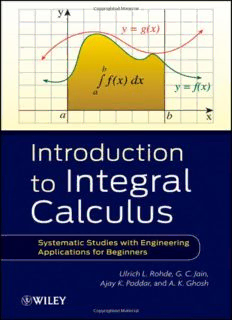Table Of Content
INTRODUCTION TO
INTEGRAL CALCULUS
INTRODUCTION TO
INTEGRAL CALCULUS
Systematic Studies with
Engineering Applications
for Beginners
Ulrich L. Rohde
Prof. Dr.-Ing.Dr. h.c. mult.
BTU Cottbus, Germany
Synergy MicrowaveCorporation Peterson,NJ,USA
G. C. Jain
(Retd. Scientist) Defense Research andDevelopmentOrganization
Maharashtra,India
Ajay K. Poddar
Chief Scientist,Synergy MicrowaveCorporation,
Peterson, NJ, USA
A. K. Ghosh
Professor, Department ofAerospace Engineering
Indian Institute ofTechnology – Kanpur
Kanpur, India
Copyright(cid:2)2012byJohnWiley&Sons,Inc.Allrightsreserved
PublishedbyJohnWiley&Sons,Inc.,Hoboken,NewJersey
PublishedsimultaneouslyinCanada
Nopartofthispublicationmaybereproduced,storedinaretrievalsystem,ortransmittedinany
formorbyanymeans,electronic,mechanical,photocopying,recording,scanning,orotherwise,
exceptaspermittedunderSection107or108ofthe1976UnitedStatesCopyrightAct,withouteither
thepriorwrittenpermissionofthePublisher,orauthorizationthroughpaymentoftheappropriate
per-copyfeetotheCopyrightClearanceCenter,Inc.,222RosewoodDrive,Danvers,MA01923,
(978)750-8400,fax(978)750-4470,oronthewebatwww.copyright.com.RequeststothePublisher
forpermissionshouldbeaddressedtothePermissionsDepartment,JohnWiley&Sons,Inc.,111
RiverStreet,Hoboken,NJ07030,(201)748-6011,fax(201)748-6008,oronline
athttp://www.wiley.com/go/permission.
LimitofLiability/DisclaimerofWarranty:Whilethepublisherandauthorhaveusedtheirbestefforts
inpreparingthisbook,theymakenorepresentationsorwarrantieswithrespecttotheaccuracyor
completenessofthecontentsofthisbookandspecificallydisclaimanyimpliedwarrantiesof
merchantabilityorfitnessforaparticularpurpose.Nowarrantymaybecreatedorextendedbysales
representativesorwrittensalesmaterials.Theadviceandstrategiescontainedhereinmaynotbe
suitableforyoursituation.Youshouldconsultwithaprofessionalwhereappropriate.Neitherthe
publishernorauthorshallbeliableforanylossofprofitoranyothercommercialdamages,including
butnotlimitedtospecial,incidental,consequential,orotherdamages.
Forgeneralinformationonourotherproductsandservicesorfortechnicalsupport,pleasecontactour
CustomerCareDepartmentwithintheUnitedStatesat(800)762-2974,outsidetheUnitedStatesat
(317)572-3993orfax(317)572-4002.
Wileyalsopublishesitsbooksinavarietyofelectronicformats.Somecontentthatappearsinprint
maynotbeavailableinelectronicformats.FormoreinformationaboutWileyproducts,visitour
websiteatwww.wiley.com.
LibraryofCongressCataloging-in-PublicationData:
IntroductiontointegralCalculus:systematicstudieswithengineeringapplicationsforbeginners/
UlrichL.Rohde.
p.cm.
Includesbibliographicalreferencesandindex.
ISBN978-1-118-11776-7(cloth)
1.Calculus,Integral–Textbooks.I.Rohde,UlrichL.
QA308.I582012
515’.43–dc23
2011018422
PrintedintheUnitedStatesofAmerica
10 9 8 7 6 5 4 3 2 1
CONTENTS
FOREWORD ix
PREFACE xiii
BIOGRAPHIES xxi
INTRODUCTION xxiii
ACKNOWLEDGMENT xxv
1 Antiderivative(s)[orIndefiniteIntegral(s)] 1
1.1 Introduction 1
1.2 UsefulSymbols,Terms,andPhrasesFrequentlyNeeded 6
1.3 Table(s)ofDerivativesandtheircorrespondingIntegrals 7
1.4 IntegrationofCertainCombinationsofFunctions 10
1.5 ComparisonBetweentheOperationsofDifferentiationandIntegration 15
2 IntegrationUsingTrigonometricIdentities 17
2.1 Introduction 17
2.2 SomeImportantIntegrÐalsInvolvingsinxandcosx 34
2.3 IntegralsoftheForm ðdx=ðasinxþbcosxÞÞ,wherea,b2r 37
3a IntegrationbySubstitution:ChangeofVariableofIntegration 43
3a.1 Introduction 43
3a.2 GeneralizedPowerRule 43
ð
3a.3 Theorem asinxþbcosx 46
3a.4 ToEvaluateIntegralsoftheForm dx;
csinxþdcosx
wherea,b,c,anddareconstant 60
3b FurtherIntegrationbySubstitution:AdditionalStandardIntegrals 67
3b.1 Introduction 67
3b.2 SpecialCasesofIntegralsandProofforStandardIntegrals 68
3b.3 SomeNewIntegrals 84
3b.4 FourMoreStandardIntegrals 85
4a IntegrationbyParts 97
4a.1 Introduction 97
4a.2 ObtainingtheRuleforIntegrationbyParts 98
v
vi CONTENTS
4a.3 HelpfulPicturesConnectingInverseTrigonometricFunctions
withOrdinaryTrigonometricFunctions 113
4a.4 RuleforProperChoiceofFirstFunction 115
4b FurtherIntegrationbyParts:WheretheGivenIntegral
ReappearsonRight-HandSide 117
4b.1 Introduction 117
4b.2 AnImportantResult:ACorollarytoIntegrationbyParts 120
4b.3 ApplicationoftheCorollarytoIntegrationbyPartsto
IntegralsthatcannotbeSolvedOtherwise 124
4b.4 SimplerMethÐopd(ffiffisffiffi)ffiffiffifffioffiffiffirffiffiffiEffiffiffivffiffiaffiffilffiffiuffiffiatingStandardIntegrals 126
4b.5 ToEvaluate ax2þbxþcdx 133
5 PreparationfortheDefiniteIntegral:TheConceptofArea 139
5.1 Introduction 139
5.2 PreparationfortheDefiniteIntegral 140
5.3 TheDefiniteIntegralasanArea 143
5.4 DefinitionofAreainTermsoftheDefiniteIntegral 151
5.5 RiemannSumsandtheAnalyticalDefinition
oftheDefiniteIntegral 151
6a TheFundamentalTheoremsofCalculus 165
6a.1 Introduction 165
6a.2 DefiniteIntegrals 165
6a.3 TheAreaofFunctionA(x) 167
6a.4 StatementandProofoftheSecondFundamental
TheoremofCalculus 171
6a.5 DifferentiatingaDefiniteIntegralwithRespectto
aVariableUpperLimit 172
Ð
6b TheIntegralFunction x1dt,(x>0)Identifiedaslnxorlog x 183
1 t e
6b.1 Introduction 183
6b.2 DefinitionofNaturalLogarithmicFunction 186
6b.3 TheCalculusoflnx 187
6b.4 TheGraphoftheNaturalLogarithmicFunctionlnx 194
6b.5 TheNaturalExponentialFunction[exp(x)orex] 196
7a MethodsforEvaluatingDefiniteIntegrals 197
7a.1 Introduction 197
7a.2 TheRuleforEvaluatingDefiniteIntegrals 198
7a.3 SomeRules(Theorems)forEvaluationofDefiniteIntegrals 200
7a.4 MethodofIntegrationbyPartsinDefiniteIntegrals 209
7b SomeImportantPropertiesofDefiniteIntegrals 213
7b.1 Introduction 213
7b.2 SomeImportantPropertiesofDefiniteIntegrals 213
CONTENTS vii
7b.3 ProofofProperty(P ) 214
0
7b.4 ProofofProperty(P ) 228
5
7b.5 DefiniteIntegrals:TypesofFunctions 232
8a ApplyingtheDefiniteIntegraltoComputetheArea
ofaPlaneFigure 249
8a.1 Introduction 249
8a.2 ComputingtheAreaofaPlaneRegion 252
8a.3 ConstructingtheRoughSketch[CartesianCurves] 257
8a.4 ComputingtheAreaofaCircle(DevelopingSimplerTechniques) 272
8b ToFindLength(s)ofArc(s)ofCurve(s),theVolume(s)ofSolid(s)
ofRevolution,andtheArea(s)ofSurface(s)ofSolid(s)ofRevolution 295
8b.1 Introduction 295
8b.2 MethodsofIntegration 295
8b.3 EquationfortheLengthofaCurveinPolarCoordinates 300
8b.4 SolidsofRevolution 302
8b.5 FormulafortheVolumeofa“SolidofRevolution” 303
8b.6 Area(s)ofSurface(s)ofRevolution 314
9a DifferentialEquations:RelatedConceptsandTerminology 321
9a.1 Introduction 321
9a.2 ImportantFormalApplicationsofDifferentials(dyanddx) 323
9a.3 IndependentArbitraryConstants(orEssentialArbitraryConstants) 331
9a.4 Definition:IntegralCurve 332
9a.5 FormationofaDifferentialEquationfromaGivenRelation,
InvolvingVariablesandtheEssentialArbitraryConstants
(orParameters) 333
9a.6 GeneralProcedureforEliminating“Two”Independent
ArbitraryConstants(UsingtheConceptofDeterminant) 338
9a.7 TheSimplestTypeofDifferentialEquations 357
9b MethodsofSolvingOrdinaryDifferentialEquations
oftheFirstOrderandoftheFirstDegree 361
9b.1 Introduction 361
9b.2 MethodsofSolvingDifferentialEquations 362
9b.3 LinearDifferentialEquations 388
9b.4 TypeIII:ExactDifferentialEquations 397
9b.5 ApplicationsofDifferentialEquations 398
INDEX 399
FOREWORD
“What is Calculus?” is a classic deep question. Calculus is the most powerful branch of
mathematics,whichrevolvesaroundcalculationsinvolvingvaryingquantities.Itprovidesa
systemofrulestocalculatequantitieswhichcannotbecalculatedbyapplyinganyotherbranch
ofmathematics.Schoolsorcollegesfinditdifficulttomotivatestudentstolearnthissubject,
whilethosewhodotakethecoursefinditverymechanical.Manyatimes,ithasbeenobserved
that students incorrectly solve real-life problems by applying Calculus. They may not be
capable to understand or admit their shortcomings in terms of basic understanding of
fundamental concepts! The study of Calculus is one of the most powerful intellectual
achievements of the human brain. One important goal of this manuscript is to give begin-
ner-levelstudentsanappreciationofthebeautyofCalculus.Whethertaughtinatraditional
lecture format or in the lab with individual or group learning, Calculus needs focusing on
numericalandgraphicalexperimentation.Thismeansthattheideasandtechniqueshavetobe
presentedclearlyandaccuratelyinanarticulatedmanner.
TheideasrelatedwiththedevelopmentofCalculusappearthroughoutmathematicalhistory,
spanning over more than 2000 years. However, the credit of its invention goes to the
mathematiciansoftheseventeenthcentury(inparticular,toNewtonandLeibniz)andcontinues
uptothenineteenthcentury,whenFrenchmathematicianAugustin-LouisCauchy(1789–1857)
gave the definition of the limit, a concept which removed doubts about the soundness of
Calculus,andmadeitfreefromallconfusion.ThehistoryofcontroversyaboutCalculusismost
illuminatingastothegrowthofmathematics.ThesoundnessofCalculuswasdoubtedbythe
greatestmathematiciansoftheeighteenthcentury,yet,itwasnotonlyappliedfreelybutgreat
developments like differential equations, differential geometry, and so on were achieved.
Calculus,whichistheoutcomeofanintellectualstruggleforsuchalongperiodoftime,has
provedtobethemostbeautifulintellectualachievementofthehumanmind.
Therearecertainproblemsinmathematics,mechanics,physics,andmanyotherbranchesof
science,whichcannotbesolvedbyordinarymethodsofgeometryoralgebraalone.Tosolve
theseproblems,wehavetouseanewbranchofmathematics,knownasCalculus.Itusesnot
onlytheideasandmethodsfromarithmetic,geometry,algebra,coordinategeometry,trigo-
nometry,andsoon,butalsothenotionoflimit,whichisanewideawhichliesatthefoundation
ofCalculus.Usingthisnotionasatool,thederivativeofafunction(whichisavariablequantity)
isdefinedasthelimitofaparticularkind.Ingeneral,DifferentialCalculusprovidesamethod
forcalculating“therateofchange”ofthevalueofthevariablequantity.Ontheotherhand,
IntegralCalculusprovidesmethodsforcalculatingthetotaleffectofsuchchanges,underthe
given conditions. The phrase rate of change mentioned above stands for the actual rate of
changeofavariable,andnotitsaveragerateofchange.Thephrase“rateofchange”mightlook
likeaforeignlanguagetobeginners,butconceptslikerateofchange,stationarypoint,androot,
andsoon,haveprecisemathematicalmeaning,agreed-uponallovertheworld.Understanding
suchwordshelpsalotinunderstandingthemathematicstheyconvey.Atthisstage,itmustalso
ix
x FOREWORD
bemadeclearthatwhereasalgebra,geometry,andtrigonometryarethetoolswhichareusedin
thestudyofCalculus,theyshouldnotbeconfusedwiththesubjectofCalculus.
ThismanuscriptistheresultofjointeffortsbyProf.UlrichL.Rohde,Mr.G.C.Jain,Dr.Ajay
K.Poddar,andmyself.Allofusareawareofthepracticaldifficultiesofthestudentsfacewhile
learningCalculus.Iamoftheopinionthatwiththeavailabilityofthesenotes,studentsshouldbe
abletolearnthesubjecteasilyandenjoyitsbeautyandpower.Infact,forwantofsuchsimple
andsystematicwork,moststudentsarelearningthesubjectasasetofrulesandformulas,which
isreallyunfortunate.Iwishtodiscouragethistrend.
ProfessorUlrichL.Rohde,FacultyofMechanical,ElectricalandIndustrialEngineering
(RFand Microwave Circuit Design & Techniques) BrandenburgUniversityof Technology,
Cottbus,Germanyhasoptimizedthisbookbyexpandingit,addingusefulapplications,and
adaptingitfortoday’sneeds.PartsofthemathematicalapproachfromtheRohde,Poddar,and
B€oeck textbook on wireless oscillators (The Design of Modern Microwave Oscillators for
WirelessApplications:TheoryandOptimization,JohnWiley&Sons,ISBN0-471-72342-8,
2005)wereusedastheycombinedifferentiationandintegrationtocalculatethedampedand
startingoscillationconditionusingsimpledifferentialequations.Thisisagoodtransitionfor
morechallengingtasksforscientificstudieswithengineeringapplicationsforbeginnerswho
finddifficultiesinunderstandingtheproblem-solvingpowerofCalculus.
Mr.Jainisnotateacherbyprofession,buthiscuriositytogototherootsofthesubjectto
prepare the so-called concept-oriented notes for systematic studies in Calculus is his
contribution toward creating interest among students for learning mathematics in general,
andCalculusinparticular.Thisbookstartedwiththeseconcept-orientednotespreparedfor
teachingstudentstofacereal-lifeengineeringproblems.Mostofthematerialpertainingtothis
manuscriptoncalculuswaspreparedbyMr.G.C.Jainintheprocessofteachinghiskidsand
helpingotherstudentswhoneededhelpinlearningthesubject.Lateron,hisfriends(including
me)realizedthebeautyofhiscompilationandwewantedtoseehisusefulworkpublished.
IamalsoawarethatMr.JaingothisnotesexaminedfromsomeprofessorsattheDepartment
of Mathematics, Pune University, India. I know Mr. Jain right from his scientific career at
ArmamentResearchandDevelopmentEstablishment(ARDE)atPashan,Pune,India,whereI
wasaSeniorScientist(1982–1998)andheadedtheAerodynamicGroupARDE,PuneinDRDO
(DefenseResearchandDevelopmentOrganization),India.Coincidently,Dr.AjayK.Poddar,
Chief Scientist at Synergy Microwave Corp., NJ 07504, USAwas also a Senior Scientist
(1990–2001)inaveryresponsiblepositionintheFuzeDivisionofARDEandwasawareofthe
aptitudeofMr.Jain.
Dr. Ajay K. Poddar has been the main driving force towards the realization of the
conceptualizednotespreparedbyMr.Jaininmanuscriptformandhissincereeffortsmade
timelypublicationpossible.Dr.Poddarhasmadetirelesseffortbyextendingallpossiblehelpto
ensure that Mr. Jain’s notes are published for the benefit of the students. His contributions
include(butarenotlimitedto)valuableinputsandsuggestionsthroughoutthepreparationof
thismanuscriptforitsimprovement,aswellasmanyrelevantliteratureacquisitions.Iamsure,
as a leading scientist, Dr. Poddar will have realized how important it is for the younger
generationtoavoidshortcomingsintermsofbasicunderstandingofthefundamentalconcepts
ofCalculus.
I have had a long time association with Mr. Jain and Dr. Poddar at ARDE, Pune. My
objectivehasbeentoproofreadthemanuscriptandhighlightitssalientfeatures.However,only
apersonalexaminationofthebookwillconveytothereaderthebroadscopeofitscoverageand
itscontributioninaddressingtheproperwayoflearningCalculus.Ihopethisbookwillproveto
beveryusefultothestudentsofJuniorCollegesandtothoseinhigherclasses(ofscienceand
engineeringstreams)whomightneedittogetridofconfusions,ifany.
FOREWORD xi
MyspecialthanksgoestoDr.Poddar,whoisnotonlyagiftedscientistbuthasalsobeena
mentor.Itwashissuggestiontopublishthemanuscriptintwoparts(PartI:Introductionto
Differential Calculus: Systematic Studies with Engineering Applications for Beginners and
PartII:IntroductiontoIntegralCalculus:SystematicStudieswithEngineeringApplicationsfor
Beginners)sothatbeginnerscoulddigesttheconceptsofDifferentialandIntegralCalculus
without confusion and misunderstanding. It is the purpose of this book to provide a clear
understandingoftheconceptsneededbybeginnersandengineerswhoareinterestedinthe
applicationofCalculusoftheirfieldofstudy.Thisbookhasbeendesignedasasupplementtoall
current standard textbooks on Calculus and each chapter begins with a clear statement of
pertinentdefinitions,principles,andtheoremstogetherwithillustrativeandotherdescriptive
material.Considerablymorematerialhasbeenincludedherethancanbecoveredinmosthigh
schoolsandundergraduatestudycourses.Thishasbeendonetomakethebookmoreflexible;to
provide concept-oriented notes and stimulate interest in the relevant topics. I believe that
studentslearnbestwhenproceduraltechniquesarelaidoutasclearlyandsimplyaspossible.
Consistentwiththereader’sneedsandforcompleteness,therearealargenumberofexamples
forself-practice.
TheauthorsaretobecommendedfortheireffortsinthisendeavorandIamsurethatboth
PartIandPartIIwillbeanassettothebeginner’shandbookonthebookshelf.Ihopethatafter
reading this book, the students will begin to share the enthusiasm of the authors in under-
standingandapplyingtheprinciplesofCalculusanditsusefulness.Withallthesechanges,the
authors have not compromised our belief that the fundamental goal of Calculus is to help
preparebeginnersentertheworldofmathematics,science,andengineering.
Finally, I would like to thank Susanne Steitz-Filler, Editor (Mathematics and Statistics)
atJohnWiley&Sons,Inc.,DanielleLacourciere,SeniorProductionEditorat JohnWiley&
Sons, Inc., and Sanchari S. at Thomosn Digital for her patience and splendid cooperation
throughoutthejourneyofthispublication.
AJOYKANTIGHOSH
PROFESSOR&FACULTYINCHARGE(FLIGHTLABORATORY)
DEPARTMENTOFAEROSPACEENGINEERING
IITKANPUR,INDIA

